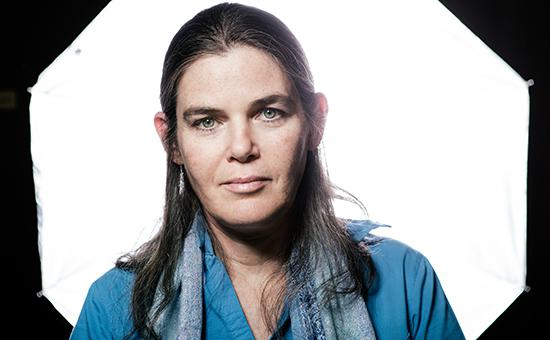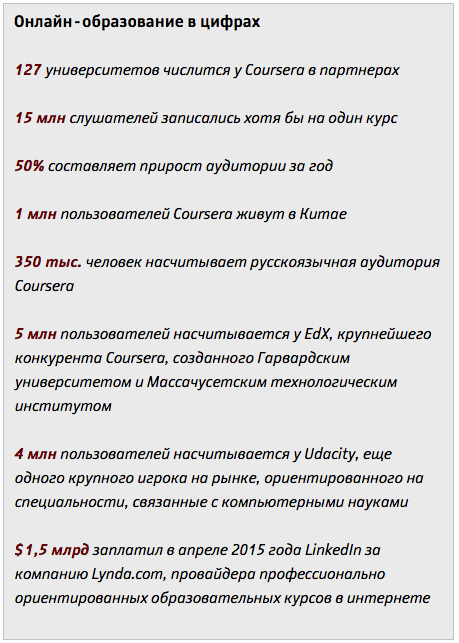Coursera President spoke about students, monetization and online education market
Coursera, one of the leaders in the online education market, has been operating since 2012. Now the site’s audience is more than fifteen million people, three hundred thousand of whom live in Russia, and three hundred fifty thousand listen to Russian-language courses from the Higher School of Economics, Moscow Institute of Physics and Technology, St. Petersburg State University and other Russian universities. The company has more than a hundred partners among higher educational institutions all over the world, and employers already take into account online education of applicants.
Coursera monetization is based on the payment of diplomas, and most of the courses are free of charge The business model allowed the company to attract one hundred thirty-five million investments from venture capital funds.
Coursera President Daphne Koller spoke about the new market for online courses that could reach a billion people.
')

Photo: Anton Berkasov for RBC
On average, 85% of Coursera students are adults. They need updated and modern information. Not everyone has the opportunity to return to a regular university after forty years, and online courses allow them to gain knowledge to perform their job duties. In China, there are more young people who use courses to supplement the university program, and in Russia there are more professionals.
More than half of users take courses to move up the career ladder. A quarter of users are studying or preparing for college, and the rest want to expand their horizons. The main revenue Coursera receives from the purchase of certificates by professionals. Half of the revenue is taken by universities, but for universities, the main thing is to increase awareness, although popular courses can significantly supplement the faculty budget.
Among Coursera users there are people who have attended from one hundred to one hundred and fifty courses, which is the full equivalent of a university computer science course.
Daphne Koller told RBC what kind of market the company counts on. Each year, up to four hundred and fifty million people get higher education, and each of them could be a student of online courses. If you add to this number of people who do not have the opportunity to get an education, then the potential audience is up to a billion people.
Coursera examines trends in the market, conducts marketing research on professional competencies, analyzes search data on its own site, collects data from job sites and determines which skills are most often mentioned and which skills are rare - if vacancies are left blank for a long time. The company asks one hundred and twenty-seven universities to produce such courses, and partners are going to meet each other, says Daphne Koller. The company does not cooperate with employers.
On the question of whether there are completely unpopular courses, Daphne replied that even the strangest courses find an audience of several thousand people. The site had a Galois theory course in French and a nanotechnology course in Arabic, which was given by a professor from an Israeli university.
Many organizations in the online education market belong to non-profit organizations - non-profit organizations. Coursera immediately followed the commercial path: “a rational system must produce enough value so that people are willing to pay.” The company is still unprofitable, but hopes in the coming years to achieve a profit thanks to the specializations for which people are willing to pay, and growth in international markets. Daphne Koller’s only exit strategy is public placement.
Investors, including Kleiner Perkins Caufield & Byers and New Enterprise Associates, do not pressure the company. The Coursra audience has grown one and a half times in nine months, and revenue growth outpaces the number of users.

Online education in numbers. RBC
Coursera monetization is based on the payment of diplomas, and most of the courses are free of charge The business model allowed the company to attract one hundred thirty-five million investments from venture capital funds.
Coursera President Daphne Koller spoke about the new market for online courses that could reach a billion people.
')

Photo: Anton Berkasov for RBC
Listeners and monetization
On average, 85% of Coursera students are adults. They need updated and modern information. Not everyone has the opportunity to return to a regular university after forty years, and online courses allow them to gain knowledge to perform their job duties. In China, there are more young people who use courses to supplement the university program, and in Russia there are more professionals.
More than half of users take courses to move up the career ladder. A quarter of users are studying or preparing for college, and the rest want to expand their horizons. The main revenue Coursera receives from the purchase of certificates by professionals. Half of the revenue is taken by universities, but for universities, the main thing is to increase awareness, although popular courses can significantly supplement the faculty budget.
Among Coursera users there are people who have attended from one hundred to one hundred and fifty courses, which is the full equivalent of a university computer science course.
Daphne Koller told RBC what kind of market the company counts on. Each year, up to four hundred and fifty million people get higher education, and each of them could be a student of online courses. If you add to this number of people who do not have the opportunity to get an education, then the potential audience is up to a billion people.
Course Topics
Coursera examines trends in the market, conducts marketing research on professional competencies, analyzes search data on its own site, collects data from job sites and determines which skills are most often mentioned and which skills are rare - if vacancies are left blank for a long time. The company asks one hundred and twenty-seven universities to produce such courses, and partners are going to meet each other, says Daphne Koller. The company does not cooperate with employers.
On the question of whether there are completely unpopular courses, Daphne replied that even the strangest courses find an audience of several thousand people. The site had a Galois theory course in French and a nanotechnology course in Arabic, which was given by a professor from an Israeli university.
Investments
Many organizations in the online education market belong to non-profit organizations - non-profit organizations. Coursera immediately followed the commercial path: “a rational system must produce enough value so that people are willing to pay.” The company is still unprofitable, but hopes in the coming years to achieve a profit thanks to the specializations for which people are willing to pay, and growth in international markets. Daphne Koller’s only exit strategy is public placement.
Investors, including Kleiner Perkins Caufield & Byers and New Enterprise Associates, do not pressure the company. The Coursra audience has grown one and a half times in nine months, and revenue growth outpaces the number of users.

Online education in numbers. RBC
Source: https://habr.com/ru/post/294754/
All Articles